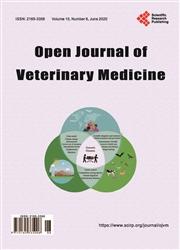Group A Rotavirus Genotypes among Calf Herds in Southwest Nigeria and Implications for Human Rotavirus Vaccines’ Efficiency
引用次数: 1
Abstract
Rotaviruses have been widely reported to be associated with diarrhea in humans but fewer studies abound on other mammalian species. This prospective study was conducted to detect and characterize Rotaviruses from freely ranged migratory herds of cattle in Ekiti and Ondo states, Nigeria with a view to further expanding knowledge on rotaviruses, possible animal-human interspecies transmission and impacts on vaccine efficiency. By convenience sampling, between September 2014 and February 2015, stool samples from 120 calves, comprising settled and migratory herds of cattle were obtained and examined for group A rotaviruses using Certest® Quadruple Enzyme Immuno Assay. Rotavirus genomes were isolated by extraction from the positive samples, reverse transcribed and amplified by One-Step reverse transcription polymerase chain reaction (RT-PCR), and genotyped by semi-nested multiplex PCR. Representative PCR products of the genotyped samples were purified and sequenced using Sanger method. The generated query sequences were queried to the GenBank to retrieve similar sequences for pairwise alignment by ClustalW. Phylogenetic analyses by Neighbour-joining method were conducted at 1000 bootstrap replicates to obtain phylograms using MEGA 6 software. Fifteen samples (15/120: 12.5%) were positive for rotavirus. No statistically significant association existed between rotavirus infection and gender of the calves (χ2 = 0, df = 1, p = 1). Eight samples (8/15: 53.3%) were successfully genotyped where the G1, G5, G9, G10, G12, and P[6] were detected. Nucleotide Sequencing of the VP7 and VP4 genes of the genotyped samples confirmed strains G1P[6], G10P[6], and G12P[6] with 58% - 100% nucleotide identity within these viruses. Phylogenetic analysis revealed 2 possible transmissions from India and Honduras. Bovine rotaviruses were detected in freely ranged and settled calf herds in southwestern Nigeria at a rate of 12.5%. The strains identified were analysed to be group A rotavirus strains with potential interspecies transmission from human to calves and from bovine to humans. The detected mixed strains could eventually impact negatively on the effectiveness of available rotavirus vaccines over the prevailing serotypes in human infections.尼日利亚西南部小牛群中的A组轮状病毒基因型及其对人轮状病毒疫苗效率的影响
轮状病毒已被广泛报道与人类腹泻有关,但对其他哺乳动物物种的研究较少。这项前瞻性研究旨在检测和表征尼日利亚埃基提州和翁多州自由迁徙牛群中的轮状病毒,以进一步扩大对轮状病毒、可能的动物-人类种间传播以及对疫苗效率的影响的了解。通过方便采样,在2014年9月至2015年2月期间,从120头小牛(包括定居和迁徙的牛群)中获得粪便样本,并使用Certest®四重酶免疫测定法检测A组轮状病毒。从阳性样本中提取轮状病毒基因组,通过一步逆转录聚合酶链式反应(RT-PCR)进行逆转录和扩增,并通过半嵌套多重PCR进行基因分型。使用Sanger方法对基因分型样品的代表性PCR产物进行纯化和测序。生成的查询序列被查询到GenBank,以检索用于ClustalW成对比对的相似序列。通过邻居连接法在1000个bootstrap重复中进行系统发育分析,以使用MEGA 6软件获得系统图。15份样本(15/120:12.5%)轮状病毒呈阳性。轮状病毒感染和小牛性别之间没有统计学意义的相关性(χ2=0,df=1,p=1)。8个样本(8/15:53.3%)成功进行了基因分型,其中检测到G1、G5、G9、G10、G12和P[6]。基因型样本的VP7和VP4基因的核苷酸测序证实了菌株G1P[6]、G10P[6]和G12P[6]在这些病毒中具有58%-100%的核苷酸同一性。系统发育分析揭示了2种可能来自印度和洪都拉斯的传播。在尼日利亚西南部自由放养和定居的小牛群中检测到牛轮状病毒,检出率为12.5%。经分析,所鉴定的毒株为a组轮状病毒株,具有从人到小牛和从牛到人的潜在种间传播。检测到的混合毒株最终可能会对现有轮状病毒疫苗的有效性产生负面影响,而不是对人类感染中流行的血清型产生负面影响。
本文章由计算机程序翻译,如有差异,请以英文原文为准。
求助全文
约1分钟内获得全文
求助全文

 求助内容:
求助内容: 应助结果提醒方式:
应助结果提醒方式:


